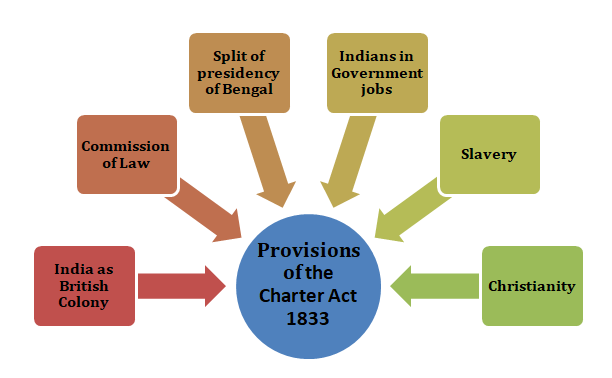

The first charter act provided the privilege of commercial activities to the British Government and was passed in the year 1793. There were other charters acts too, such as the Charter act of 1813, the next act of 1833 and the last one was an act of 1853. However, the impact of the Charter act of 1833 was powerful.
The Charter Act of 1833 was also referred to as the Government of India Act of 1833 and it was known as the Saint Helena act of 1833. The main purpose of the act was to enable the charter for another 20 years. The act put a stop to the commercial activity of the company. This law ensures the establishment of the executive body, which is known as the Law commission, which will act upon the laws and values of India.
Lord Macaulay actively participated in the making of this law as he was the governorgeneral of the council of India of that time. He was also the first chairman of the executive body known as the commission of Law.
The main features of the act are −
The commercial activities of the company ended with the act.
It ensures an administrative body for the possession of the British Indians.
The trade link of the company that was made with China also got close with this act.
It provides permission to the British for settling freely in India.
The colonisation of the country became legalised.
Territories of India were still under the company but now with a slight change.
The charter was extended to another 20 years.
Some of the provisions of the act are −
India as British Colony - The post of governor-general that was for Bengal was made the governor-general of India. The first person on this post was Lord William Bentinck. The administration of this county came under the control of one. The legislative power of the governors of madras and Bombay was lost. Because of the act for the first time, the government was called The government of India and eventually, the council became the council of India. The council was made of four members but the power of the fourth member was limited.
Commission of Law - Because of the act, an executive body was made to reform all the legal tasks. It ensures that any act needs to be put before the parliament of the British and only then they will consider as an act. It leads to the codification of the law.

The Provisions of The act
The division of the presidency of Bengal - The act was about a division of the presidency of Bengal and divided into Agra and Fort William. However, it never came to effect.
Indians for Government jobs - The main thing about the act that plays a great role for the Indians was this part. It was the first act that ensure and provides permission for Indians to participate in the administration of India. The merit will not be decoded based on any religion, caste, race, colour etc, which gave everyone an equal chance of employment.
Slavery - This act weakened the slavery that existed in the country. It also abolished slavery in Britain.
Christianity - As a result, an increasing number of residents of British India lead to allow in having bishops in this country (Vennila, G. 2018). It leads the establishment of institutions run by Christians in India.
The Charter act enacted in 1833 was crucial in many aspects because it helps to shape India's political and constitutional history.
The act made a great impact on the changes made by the industrial revolution that occurred in Britain.
This act was formed in an atmosphere of ideas and reforms that were all about liberalisation.
It helps to centralise the administration of India.
It opens up the opportunity to work for Indians in the service of the government. It means the act helps Indians to admit to the administration freely.
Lord Macaulay ensures the codification of the law.
All the commercial activities of the British East India Company ended with the act.
It made the Governor-general of Bengal of India.
The first step towards spreading the administration in India was taken through the charter act of 1833. A crucial act plays the main role for the government of Britain. Some features of the act help to shape the future of India, which created history. Most importantly, it laid down the concept of appointment of Indians in the service of the company based on race, caste and religion.
Q.1. Why the Charter Act of 1833 is so important?
Ans. The charter act of 1833 plays a crucial role in the centralisation of the administration of India. It was also important because it starts the ending of the commercial activities of East India Company.
Q.2. When was the first charter act introduced?
Ans. The first charter act was introduced in the year 1793. This act was also known as the East India Company Act 1793 and it was passed in the Parliament under British rule. The company charter was renewed through the act.
Q.3. What was the last charter act?
Ans. The last charter act was passed in the year 1853, and the act has a major effect on the large Indian territory that was colonised by the British.
Q.4. What was the reason behind passing the Regulating act?
Ans. The Regulating Act was passed and enacted because of the lack of management by the Government of British East India, which results in the situation of insolvency. The act provided the company with permission to retain all the territorial custody in India.